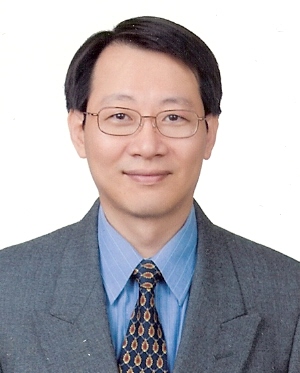林恭如 Gong-Ru Lin
主要研究領域:
奈米矽晶光子學, 光纖雷射, 全光通信訊號處理Major Research Areas:
Si Nanophotonics, Femtosecond Fiber Lasers, All-Optical Communication Data Processing研究領域摘要:
1. 飛秒主動與被動鎖模光纖雷射系統(開發超快雷射技術與光電量測通信應用)
本研究群探討奈米碳晶、石墨與石墨烯之光學應用,特別是在利用這些奈米或量子結構碳化物半導體作為飽和吸收體,作為被動鎖模光纖雷射的啟動機制進行超短雷射光脈衝的產生與動力學分析。本實驗室也分別以摻鉺光纖與半導體光放大器兩種元件為環型光纖雷射的增益介質,探討達40GHz高重複頻率主動鎖模光纖雷射的基礎特性與各種技術架構,開發光注入鎖模理論建構單模/短脈衝/高重複率的光纖雷射系統。實驗室在光纖雷射系統的指標性成果包括約分諧波鎖模技術、調制光背向注入鎖模理論與技術等,使其可能應用於超快量測、高速光通信、以及材料分析等領域。這個領域研究目前在國內隸屬於前沿雷射光學發展課題。
2. 全光通訊信號處理(特殊半導體雷射與光放大器傳輸器在被動光纖網路應用)
在光纖通信系統的建構研究中,本實驗室自行設計並開發新穎的弱共振腔半導體雷射二極體,藉由新進研發的自/互回饋或者外部同調光源注入鎖定理論與技術建立下,成功的發展在全光通信系統中訊號格式轉換器、邏輯閘、與決定閘的研究。此一特殊元件特別在光無線通信與毫米波在光纖傳輸的未來應用方面,將因為都會區高密度分波多工被動光纖網路的逐漸普及化,促使其於光纖通信領域分時與分波多工網路介面銜接光路上有極高應用潛力。本實驗室在這方面的研究有相當著墨也與中華電信已有多年之密切合作。
3. 奈米矽/碳化矽晶光子技術(奈米矽發光與光波導元件與光互連晶片系統應用)
本實驗室專注於開發多樣性奈米矽與碳化矽晶結構之特殊製程,並探討這類四族元素與化合物半導體奈米量子點、奈米角錐、與奈米針狀結構、以及其特殊電學與光學特性之物理機制。我們的目標是發展以奈米矽量子侷限效應為基礎之發光與光電元件,並研究推演其物理模型以及在光互聯系統晶片之可能應用。本研究群已開發超低臨界功率電漿輔助氣相沉積、二氧化碳雷射快速升溫退火、與表面自聚合金屬奈米結晶點等世界首度發表之新穎製程。關於矽與碳化矽奈米量子點的基礎與應用研究,本實驗室長年獲得台積電公司在產學合作研發計畫之補助。
本實驗室在光纖雷射、全光通信、與奈米矽晶研究成果重要貢獻:
A. 奈米石墨粉體作為飽和吸收體之飛秒級被動鎖模光纖雷射系統
B. 重複率10-40GHz諧波/約分諧波鎖模飛秒光纖雷射光固子脈衝壓縮
C. 弱腔模寬頻雷射二極體在高密度分波多工被動光纖網路通信領域之應用
D. 注入鎖定雷射二極體進行全光OC-192 NRZ/RZ高速通信訊號格式轉換
E. 奈米矽與碳化矽晶發光二極體與光波導主動元件之物理機制與效應探討
F. 超快光導開關為基礎之毫米波光電式鎖相迴路與相位偏移器之應用
Research Summary:
We concentrate our research on developing versatile specific synthesizing processes for Si nanostructures and related devices, investigating the physical mechanisms behind the material, electrical, and optical aspects of the Si nanodots, nanopyramids and nanopillars. The targets are implementing Si nanophotonic devices based on quantum confinement effect, and discuss in more detail the origin of the enhancement on radiation/detection, solar energy conversion, and surface plasmonic resonance at blue-green wavelength region. A future collaboration with Academia Sinica on the ab initio atomic potentials based boundary integral Green function for the quantum computation of Si quantum dots with atomic numbers ranging between 103-104 will be initiated to study the electrical property of Si nanocrystals. These simulations will be helpful to elucidate the carrier transport and penetration between Si nanocrystals and neighborhood dopants, and to realize the surface plasmonic wave interaction between Si nanostructures and biomoleculars. Several featured researches including ultra-low threshold ICP power PECVD synthesis for Si nanopyramids, CO2 laser based rapid thermal annealing for precipitating Si nanocrystals, rapid self-aggregated metallic nanodot array for SPR or nano-lithographical applications will be introduced in the following sections.
On the other hand, we are interested in fundamental and technical study of fiber laser schemes for potential applications on ultrafast optoelectronic diagnosis, high-speed fiber-optic communications, and biophotonic or biomedical analysis, etc. Over past years, we have constructed several types of continuous-wave and shorted-pulsed Erbium-doped fiber amplifier or semiconductor optical amplifier based fiber ring lasers. In particular, we have theoretically simulated and experimentally established an optical injection mode-locked semiconductor optical amplifier fiber laser system, which exhibits femtosecond pulsewidth after external soliton compression and facilitates high-repetitive low-supermode-noise output. The other milestones of our works include 40th-oeder rational harmonic mode-locking of EDFL using a FPLD based mode-locker, mutual injection-locked EDFL/EDFL and FPLD link, tipped fiber based low-splicing-loss fusion technology between different fibers, >10GHz backward optical injection induced cross-gain-modulation for mode-locking, etc. In brief, the distinguished researching fields on Si nanophotonics, fiber lasers, and all-optical communication data processing likes are emphasized in our laboratory, which include:
A. Nanocrystallite Silicon SiCx, SiNx or SiOx Based LEDs and Solar Energy Photonics
B. Femtosecond Mode-Locked Fiber Lasers and Soliton Compressors
C. All-Optical OC-192 NRZ/RZ BPSK/OOK Communication Data Format Processing
D. Injection-Locked Laser Diode or Semiconductor Optical Amplifier Based Fiber-Optic WDM-PON
E. Millimeter-wave Optoelectronic Phase-Locked Loops and Phase Shifters

-
B.S.
Soochow University, 1988 -
M.S.
National Chiao Tung University, 1990 -
Ph.D.
National Chiao Tung University, 1996
-
Address
BL-519,
Department of Electrical Engineering,
National Taiwan University,
Taipei 106, Taiwan -
Phone
+886-2-33663700 Ext.6519 -
FAX
02-33669598 -
Email:

-
Office Hour
Tuesday 10:00-12:00